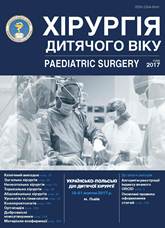Atresia of sigmoid colon (a case report and literature review)
DOI:
https://doi.org/10.15574/PS.2017.56.16Keywords:
atresia of the sigmoid colon, necrotizing enterocolitis, peritonitisAbstract
Atresia of the colon is a rather rare pathology. Still there are a lot of debates about the etiopathogenesis of this disease, its combination with concomitant pathology and its possible complications. The article deals with questions of diagnostics and treatment of colon atresia, also presented a rare clinical case – combination of the sigmoid colon atresia and the necrotic enterocolitis in the newborn.References
Karavaeva SA. (2002). Diagnosis and features of the clinical course of necrotizing enterocolitis in children. Vestnik chirurgii. 161(4): 41– 44.
Rusak PS, Kovpanets BP, Belej RP. (2005). Ulcerative-necrotizing enterocolitis. Paediatric Surgery Ukraine. 1: 104 – 108.
Etensel B, Temir G, Karkiner A et al. (2005). Atresia of the colon. J Pediatr Surg. 40: 1258-1268. https://doi.org/10.1016/j.jpedsurg.2005.05.008; PMid:16080929
Baglaj M, Carachi R, MacCormack B. (2010). Colonic atresia: a clinicopathological insight into its etiology. Eur J Pediatr Surg. 20: 102-105. https://doi.org/10.1055/s-0029-1242735; PMid:20027542
El-Asmar MK, Abdel-Latif M, El-Kassaby AA et al. (2016). Colonic atresia: association with other anomalies. Journal of Neonatal Surgery. 5(4): 147-153. https://doi.org/10.21699/jns.v5i4.422; PMid:27896155 PMCid:PMC5117270
Mustafa G, Mirza B, Bashir Z, Sheikh A. (2010). Delayed recognition of type I sigmoid-colon atresia: the perforated web variety. APSP J Case Rep. 1: 118-123.
Benawra R, Puppala BL, Mangurten HH, Booth C, Bassuk A. (1981). Familial occurrence of congenital colonic atresia. J Pediatr. 99: 435-436. https://doi.org/10.1016/S0022-3476(81)80340-X
Mirza B, Iqbal S, Ijaz L. (2012). Colonic atresia and stenosis: our experience. Journal of Neonatal Surgery. 1(1): 4-8. PMid:26023363 PMCid:PMC4420311
Fourcade L, Shima H, Miyazaki E, Puri P. (2001). Multiple gastrointestinal atresias result from disturbed morphogenesis. Pediatr Surg Int. 17: 361-364. https://doi.org/10.1007/s003830000560; PMid:11527166
Puri P, Fujimoto T. (1988). New observations on the pathogenesis of multiple intestinal atresias. J Pediatr Surg. 23: 221–225. https://doi.org/10.1016/S0022-3468(88)80726-7
Singh V, Pathak M. (2016). Congenital neonatal intestinal obstruction: retrospective analysis at Tertiary Care Hospital. Journal of Neonatal Surgery. 5(4): 49–53. https://doi.org/10.21699/jns.v5i4.393; PMid:27896157 PMCid:PMC5117272
Soni V, Valse PD, Vyas S. (2014). Colonic atresia due to internal herniation through the falciform ligament defect: A case report. Journal of Neonatal Surgery. 3: 21–22. PMid:26023492 PMCid:PMC4420329
Fairbanks TJ, Sala FG, Kanard R et al. (2006). The fibroblast growth factor pathway serves a regulatory role in proliferation and apoptosis in the pathogenesis of intestinal atresia. J Pediatr Surg. 41: 132–136. https://doi.org/10.1016/j.jpedsurg.2005.10.054; PMid:16410122
Verma A, Rattan KN, Yadav R. (2016). Neonatal intestinal obstruction: a 15 year experience in a Tertiary Care Hospital. . https://doi.org/10.7860/JCDR/2016/17204.7268
Downloads
Issue
Section
License
The policy of the Journal “PAEDIATRIC SURGERY. UKRAINE” is compatible with the vast majority of funders' of open access and self-archiving policies. The journal provides immediate open access route being convinced that everyone – not only scientists - can benefit from research results, and publishes articles exclusively under open access distribution, with a Creative Commons Attribution-Noncommercial 4.0 international license(СС BY-NC).
Authors transfer the copyright to the Journal “PAEDIATRIC SURGERY.UKRAINE” when the manuscript is accepted for publication. Authors declare that this manuscript has not been published nor is under simultaneous consideration for publication elsewhere. After publication, the articles become freely available on-line to the public.
Readers have the right to use, distribute, and reproduce articles in any medium, provided the articles and the journal are properly cited.
The use of published materials for commercial purposes is strongly prohibited.

